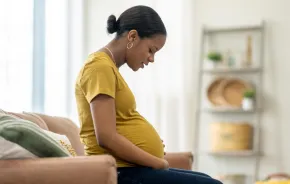It's no wonder pregnancy and birth take a toll on the body. After the pregnant body grows a tiny human, birth requires it to heroically present that fully formed being to the world. Understanding the physiological effects of pregnancy and birth can help women appreciate their new maternal bodies and regain fitness.
One key area affected by childbirth is the abdomen. "The long, flat muscle that extends vertically the length of your abdomen lengthens 120 percent by the end of pregnancy," physical therapy physician April Bolding says. "This fact renders abdominal muscles less effective in protecting the back and maintaining good posture. For women who experience diastasis rectii (widening of the connective tissue between the front muscles of the abdomen) as a result of pregnancy, this problem is compounded."
The key to abdominal recovery is strengthening the innermost layer of abdominal muscle. A physical therapist can guide you through targeted exercises to heal diastasis rectii and safely improve core strength. Bolding recommends that postpartum women avoid intense abdominal workouts, such as group Pilates mat sessions, because they can easily injure themselves by muscling through the exercises.
But starting out with some private Pilates lessons from a skilled instructor can safely improve core strength. Dorothee VandeWalle of Metropolitan Pilates in Seattle's University Village explains, "Pilates exercise must be customized for every person. With private sessions, clients receive support to improve their skills, strength and flexibility." Yoga can be another way to gently and effectively improve core strength as part of a postpartum exercise routine.
Along with the abdominal muscles, pregnancy also takes a toll on the pelvic floor, which bears the pressure of the growing fetus. "While pregnancy and sometimes traumas associated with birth can result in pelvic floor injury, Caesarean sections will not guarantee avoidance of pelvic floor damage," explains Peg Maas, physical therapist at Swedish Medical Center and clinical faculty member at the University of Washington and the University of Puget Sound. "All women are vulnerable to pelvic floor damage, even those who have never been pregnant."
Pelvic floor weakening can lead to incontinence and may interfere with the ability to exercise comfortably. Bolding warns postpartum women to avoid exercises such as lunges, stairs, or other asymmetrical movement. "You need to stabilize the pelvis before using hand weights or beginning any real exercise routine," she says.
Strengthening the pelvic floor throughout your lifetime is vital to maintaining pelvic floor health. By working with a physical therapist, you can help address pelvic pain or incontinence safely.
Relaxin is a hormone that causes softening of the ligaments, essential for the feat of a vaginal birth. "We don't really know how long relaxin stays active in the postpartum body," Maas says. "Some believe it lasts until 12 months after weaning. The implications of this apply to every joint in the body. Pregnant and postpartum women should take special care to be gentle on their joints." This means postpartum women should be cautious in yoga and Pilates practice to avoid overstretching. Gentle, non-impact exercises are best, allowing the postpartum body to reenter the world of fitness safely.
"It is a shame when women in the first month postpartum -- with all of the exhaustion and joy of those early weeks of parenting -- are preoccupied with weight loss," Maas says. "Postpartum women should be gentle with themselves and address foundational issues like core and pelvic strength and stability before beginning a serious exercise routine designed to help with weight loss."
Does age make a difference? According to Bolding, the baseline of pre-pregnancy fitness is more important than age. However, adds Tracy Weber, yoga therapist and owner of Whole Life Yoga in Seattle's Greenwood neighborhood, "Older bodies are less resilient, and changing your life a lot when your life is very established can be challenging."
At 40 years old and with what she admits is a genetically leaner body, Laurie Apfel of Redmond exercised regularly at her gym, walked and used fitness videos at home after having her baby. Still, she didn't find herself reaching her pre-pregnancy size until more than a year after giving birth. She adds that her postpartum body is definitely not her pre-pregnancy body. This is perfectly natural. While many women are familiar with the loose skin, stretch marks and surgical scars that pregnancy can produce, the body may also experience structural changes, such as widening of the feet, ribs or hips, according to Maas.
Still, some women find postpartum exercise inspires in them a new love of fitness. Katie Sluss of Richmond Beach participates in a stroller exercise class with her baby. Says Sluss, "I try to attend Stroller Strides five days a week, and I am actually in better shape than before my children were born."
Tera Schreiber, a freelance writer in Seattle, continually aspires to attain both fitness and an appreciation of her mother-body.
Your body after birth resources
- Metropolitan Pilates
www.metropolitanpilates.com
206-525-9900 - Whole Life Yoga
www.wholelifeyoga.com
206-784-2882 - Baby Boot Camp -- with locations in Redmond, Sammamish, Issaquah and Woodinville
www.babybootcamp.com
425-281-1635 - Stroller Strides -- with locations in Auburn, Issaquah, Kent, Maple Valley, Olympia, Seattle, Snoqualmie and Southcenter
www.strollerstrides.com
1-866-FIT-4MOM - Kathe Wallace, PT
www.kathewallace.com
206-527-2800 - Peg Maas, PT
206-386-2035 - Wild Grace Arts
Center for Yoga & Health
www.wildgracearts.com
360-754-3983 - Creative Dance Center
www.creativedance.org
206-363-7281 - Ever Since I Had My Baby: Understanding, Treating, and Preventing the Most Common Physical Aftereffects of Pregnancy and Childbirth, by Roger Goldberg











